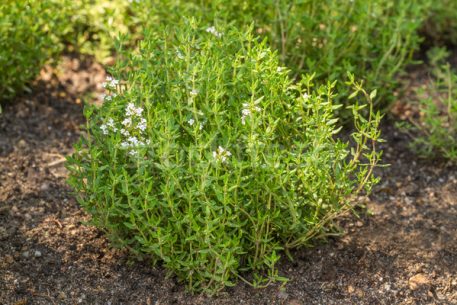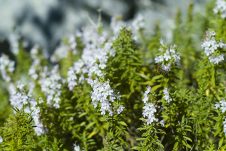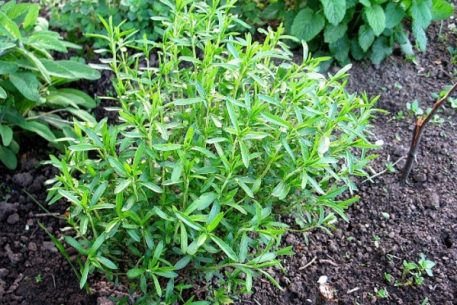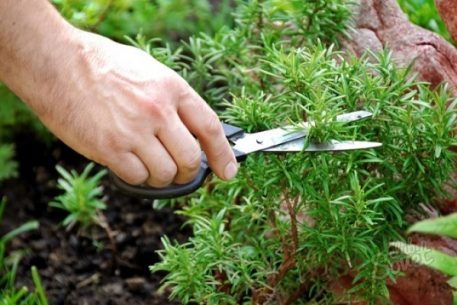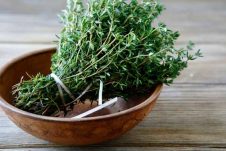Savory, who came from the Mediterranean countries to central Europe thanks to the monks, in a short time won recognition in many national cuisines. Seasoning from a plant that can easily be grown on its own plot is appreciated by many culinary specialists,
Material Content:
Description of the savory plant (Satureja)
The large family Yasnotkovye includes a large number of genera, among which a fragrant savory that grows in the form of a bush or a shrub deserves special attention. The aerial part of the herbaceous plant is represented by branched shoots covered with whole leaves on short petioles. In the flowering phase, fragrant flowers of lilac color bloom, on the place of which fruits form in the form of nuts over time. Grass has medicinal properties.

Types and varieties with names
In the natural environment, the genus Satureja is represented by almost 50 species.
In culture, the 4 forms are most common:
- Savory garden. A plant up to 45 cm tall with branched shoots exuding a distinct aroma before flowering, during which the bushes are covered with lilac flowers. Popular varieties: Oster, Summer Savor.
- Savory mountain or winter. The species is represented by evergreens, which are practically devoid of aroma, which is inherent in the previous form. In areas with more severe climates, leaves fall off after frosts.
- Savory spikelet. A semi-shrub plant, represented by twig shoots, densely leafy narrow leaves of a saturated green color. When flowering occurs in the summer months, white or pink flowers bloom.
- Savory blunt.View of plants with elegant numerous shoots covered with oppositely arranged leaf plates of simple shape. It is found in the wild in the Caucasus, in Turkmenistan.
Planting savory in the open ground
To have a spice shop and a home pharmacy on hand, it is enough to plant a savory on your site.
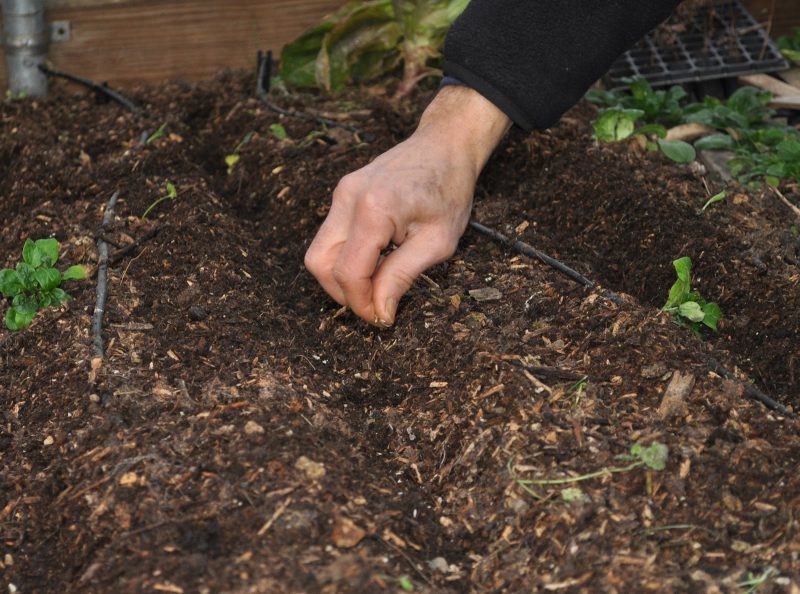
Savory, it is a pepper grass, photophilous and comfortable in sunny, sheltered from the wind areas.
Fertile soil with a loose structure and a slightly acid reaction should be dug up before planting, applying organic fertilizers in the form of compost or humus and removing the roots of weeds, with which the fragrant plant does not get along well.
Planting pepper grass in the garden is carried out in the second half of April or in the winter method after the first frosts according to the following scheme:
- In the selected area, grooves with a depth of 1 cm are made with a distance of 25 cm between each other.
- Seeds are not planted, but are mulched with humus.
- When the seedlings appear, the crops are thinned so that there is an 8 cm distance between the seedlings.
- After the formation of the third pair of true leaves, another thinning is carried out, in which the distance between plants increases to 15 - 20 cm. Https: //www.youtube.com/watch? V = QP4psnC1BqA
How to care for a plant
Growing savory in the garden provides for the implementation of simple measures for the care of fragrant grass:
- Watering. Pepper grass likes moderate moisture, in which the earth will not dry out much. Immediately after sowing seeds to ensure friendly seedlings, it is recommended to irrigate every 2 days. Subsequently, the interval increases by 2–3 times, depending on weather conditions.
- Fertilizing and fertilizers. So that the bushes are dense and the yield is large, the beds should be enriched with nitroammophos before sowing the seeds and after harvesting the grass. To maintain soil fertility, the introduction of nitrogen in an accessible form in organic fertilizers in spring will not be out of place.
- Weeding, cultivating and mulching. To ensure the required soil friability, it is necessary to periodically loosen the aisles, while removing weeds. To reduce labor costs for such procedures, as well as to prevent the rapid evaporation of moisture, you can cover the near-stem area of planting with a layer of mulch.
Savory: reproduction methods
Savory is an annual plant, so it is grown from seeds in a seedling-free and seedling way.

To plant strong seedlings in open ground in late spring, you must:
- Prepare a container for seedlings and fill it with a light sand-peat substrate, previously disinfected in the oven.
- Spread the seeds on the surface of the soil and gently press.
- Cover the container with glass and put in a bright room, where in 10 days shoots will appear.
- After the formation of the second pair of real leaves, the seedlings are cut into separate containers, where they will continue to develop until planting in the garden.
To get the seed yourself, you need to cut the shoots with fully ripened seed bolls, and then hang them over pre-spread paper. When all the seeds have crumbled, they need to be dried and laid out on paper bags.
Important! If there is already pepper grass on the site, then it can perfectly reproduce by self-sowing.
Collection and storage of grass
In order for the fragrant plant to retain all the useful elements, it is necessary to properly collect and store the crop. It is recommended to start harvesting the savory at the beginning of the flowering phase. At this time, the shoots are cut with a sharp tool at a height of 10 cm from the ground. Cut grass can be used fresh, extending the period of use by several days by placing a fragrant bouquet in water.
If you plan to store grass for a long period of time, then the savory must be dried.
- The cut off aerial part is laid out in a single layer on parchment in a dry, slightly shaded, ventilated area.
- After complete drying, it is recommended to cut off the leaves and inflorescences.
- Then place them in sealed glass jars or cloth bags.
Attention! During storage of the crop, it is recommended to check it for signs of rotting.
Savory and thyme: what is the difference?
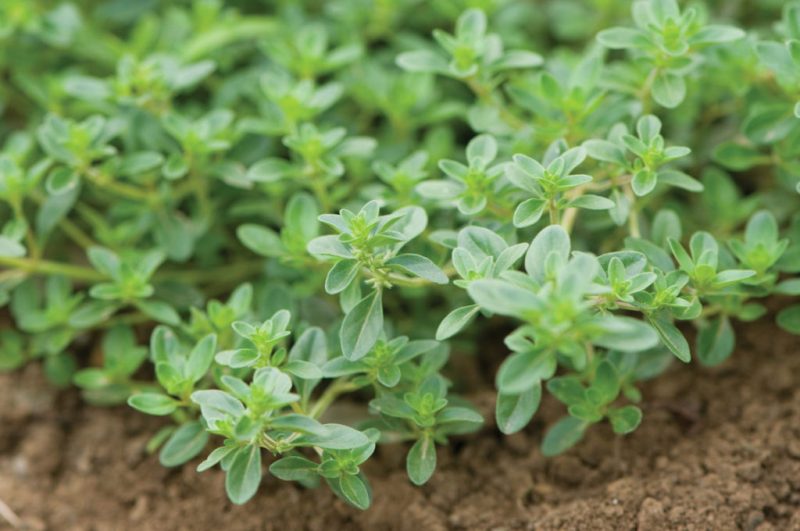
Both herbaceous plants belong to the family Iasnatkovye, but belong to different genera and have a number of differences:
- The official name. Savory, he's a satura. Thyme is known as thyme.
- Appearance. The rather tall bushes of the savory cannot be confused with a stunted, flowering thyme, the shoots of which spread along the ground.
- The aroma. Savory exudes a more intense aroma of herbs.
The healing properties of savory
Savory, characterized by a strong aroma, spicy and spicy taste, is used not only in cooking. Due to its medicinal properties, the plant is used in the preparation of potions to stimulate appetite, treat digestive disorders, vomiting, and diseases of the gastrointestinal tract.
Pepper grass has a diaphoretic, diuretic, anthelmintic and bactericidal effect. To raise the tone and relieve stress received during the working day, it is recommended to use a decoction of grass in preparing the evening bath.
Thus, the unpretentious savory, organically blending into the garden composition, is a source of useful trace elements contained in a rich harvest, which will last for several years ahead.


